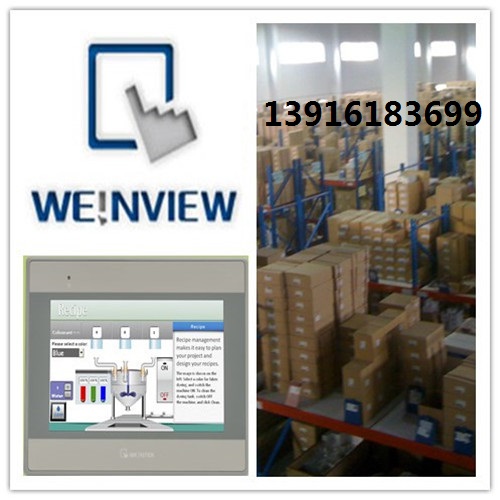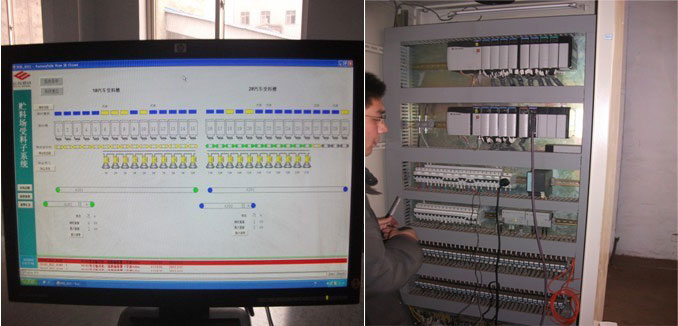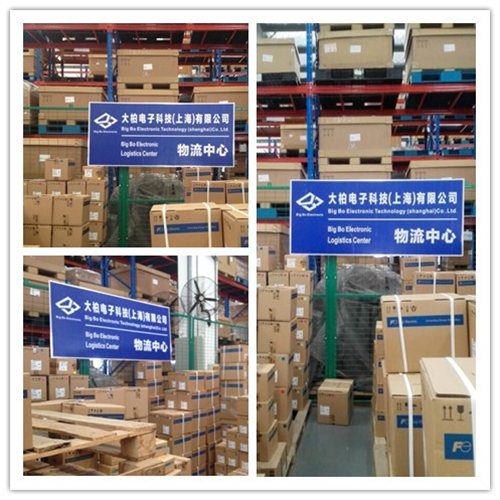Application of PR0FIBUS-DP Communication in Batching System of Tai Steel Group
I. Introduction
PROFIBUS is an international, open asynchronous serial communication standard that is widely used in various industries such as manufacturing automation and process automation, buildings, transportation, and power. Through PROFIBUS, information exchange between automation equipment and components of various manufacturers can be easily realized. The PROFIBUS protocol standard consists of three compatible parts: PROFIBUS-DP (distributed peripherals), PROFIBUS-FHS (fieldbus information specification), and PROFIBUS-PA (process automation). The standardized fieldbus has an "open" communication interface and a "transparent" communication protocol that allows users to select discrete IO devices and field devices from different manufacturers. Fieldbus PROFIBUS meets the important requirements for field-level data accessibility in the production process. On the one hand it covers the communication requirements in the field of sensor actuators and on the other hand it has all the network communication functions in the cell level domain. Especially in the field of "Distributed IO", PROFIBUS has become a de facto internationally recognized standard due to the availability of a large, comprehensive range of connected field devices.
This paper introduces the main functions, characteristics, working principles, control methods and configuration selection of the reform of the batching control system in the raw material plant of a steel plant of Tai Steel Group. In recent years, the iron and steel smelting industry in China has developed rapidly. Sintered ore is the main raw material for ironmaking, and the technological process of furnish is an important link influencing the quality of sinter. Each weighing equipment can guarantee the quality of ore only if it reaches a certain precision.
The traditional sintering process mainly relies on work experience to adjust, there are the following problems: 
A, can not be adjusted in time ratio, lower production efficiency.
B. Due to the lack of metering equipment, there are many man-made influencing factors, materials are not well controlled, waste is serious, production costs are greatly increased, and the rate of failure is high, resulting in a large amount of waste products.
C. Due to the serious dust pollution of materials, it seriously affects the health of workers. In recent years, the degree of automation of industrial processes in steel plants has become higher and higher and people’s awareness of environmental protection has been enhanced. Frequency conversion technology has been widely used at home and abroad for its excellent performance.
Second, the main functions and features of the ingredients control system
2.1, the main function of the control system
A. Monitoring function: It can detect and monitor the parameters such as instantaneous flow rate, daily total, monthly total, annual cumulative, etc.
B, screen display: Through the computer display can display the operating parameters of the control parameters in the process of ingredients, and display real-time ingredients curve and form;
C, print management: can print the ingredients report at any time, in order to save and query;
D. Communication function: Two-way data and information exchange can be carried out between IPC and PLC and batching weighing instrument;
E. Data processing: The system can automatically process the collected signals and output them to the corresponding control volume.
F, control function: According to the corresponding set value before operation, automatic control of the normal operation of equipment, including PID adjustment;
G. Alarm function: The host computer alarms the abnormality of various parameters or equipment status by means of screen mode and acousto-optic signal.
2.2. The main features of the iron plant's batching control system
A. A small and medium-sized distributed control system was adopted in the batching system structure to achieve "decentralized control and centralized management" and overcame the "dangerous concentration" problem;
B. The upper computer and the lower computer are relatively independent. It has manual, automatic and semi-automatic switching functions. When online, they exchange information with each other according to a specific protocol. When offline, a single scale can independently realize the process closed-loop process control.
C. The upper computer is far away from the operation site, which improves the stability of the system and improves the working environment of the operator.
D, the lower position machine chooses the programmable controller, has the very strong antijamming ability, the programming is simple is easy to grasp, in the harsh environment long-term reliable movement;
E. Using PID regulation to improve the dosing system's dosing accuracy, and according to the production requirements, set the best working switching timing, better solve the problem of feed end, and automatically modify the material ratio of the system.
Third, the ingredients system structure and working principle
3.1, overall structure of the control system topology and system schematics
The system consists of two PLC systems and a host computer monitoring system. The PLC system consists of two AB-300 master stations and 26 conveyor weighing conveyors as slave stations and dedicated communication cables. The master station and slave station communicate via PROFIBUS-DP.
The upper computer monitoring system adopts WindowsXP operating system, installs RSlogix5000 programming software and controls 6.0 configuration software. The overall topology of the control system and the system schematic are as follows:


System schematic
A, upper computer: Real-time monitoring of the entire system, screen display and report printing;
B, PLC: Automatic control of ingredients;
C. Dosing instrument: It is used for the PID adjustment of the ingredients and the display of the parameters such as the instantaneous flow and the accumulated flow;
D, control cabinet: logic control and power distribution for the system;
E. On-site hands-on box: It is used to start and stop the single equipment on site.
3.2, the operating mode of the system
Each batch is called manual, semi-automatic, automatic three control methods
A, manual, the field control box and instrument box switch to the manual position, from the on-site control box on the start button, potentiometer, frequency table, etc. to achieve control, by the weighing instrument shows the instantaneous amount of material and accumulation the amount. Mainly used for network system failure PLC control system failure or other reasons, need to manually repair the emergency operation under test conditions.
B, semi-automatic, the field control box and instrument box switch to the automatic position, the on-site control box on the start and stop button, frequency meter, weighing display control, etc., can be set by the weighing instrument The recipe automatically adjusts the dosage and displays the instantaneous and cumulative amounts of the material. Mainly used when no upper control is required.
C. Fully automatic, switch the switch of the instrument box to the linkage position. The upper computer controls the start and stop of the belt, dynamically displays the amount of each material, the running status of the belt, and various alarm indications. The amount of each ingredient is determined by the upper computer according to the process requirements. The unified setting can collect and process the weighing signal and switch status from each batching control loop, realize the whole system of belt weigher feeding, weighing detection, material quantity adjustment, automatic selection and switching of ingredient processes such as silo and so on. control. At this point, the on-site manual control system does not work and is completely operated through the central control room.
3.3, start and stop of automatic operation system
Four ways: sequence start, sequence stop, emergency stop, simultaneous start
A. Sequential start: for the initial start of the system or system restart after the sequence stop, the sequence start function can control the feeding equipment participating in the batching to start at a certain time interval according to the running direction of the belt to ensure that the material head can be aligned.
B. Sequential stop: It is used in occasions where you want to stop for a long time. This ensures that all the materials on the conveyor belt are transported cleanly, the belt is in the material state, and the tail alignment can be ensured.
C. Emergency stop: It is used in case of emergency stop of all equipment involved in the batching.
D. Simultaneous start: For restart after an emergency stop, the system can be run at the last “breakpoint†and then run down as if nothing had happened.
Note: It is not possible to click any of these four buttons in a random order and must be operated as required.
3.4, the control of the amount of material
A. When the required ratio of a certain amount of material is determined, it is input as a set value to the host computer and transmitted to the weighing instrument via the network. The material falls on the weighing belt and its weight is detected by the load cell, and the feedback voltage signal (0-30mV) of the material flow (measurement value) is obtained to the weighing control instrument and calculated to become the PV current value, and then output by the PID operation. The ~20mA control signal is sent to the frequency converter to change its U/F output value, thereby changing the belt speed to control the amount of material and achieve automatic batching.
B. Control of Material Proportioning: The feeding task of the system is controlled by the ratio input and calculation of the upper computer. It is to input the process parameters of various raw materials into the computer, and the computer can directly set and match the proportion of each material.
C. Automatic dumping control: The same material is installed in several silos (such as concentrate powder). Only part of silo feeding is used in production, and it is required to occur in a feeding silo. In case of failure (no material, blocking material, mechanical failure, etc.), the control system automatically starts a silo feeding system that satisfies the conditions and does not participate in the batching according to the program setting.
D. Automatic adjustment of the fuel flow value: When the equipment is shut down, the total amount of concentrate powder decreases one by one with the silo. At this time, the program automatically gradually reduces the amount of fuel to be discharged to ensure that the original ratio does not change.
Fourth, system equipment selection
4.1, network system selection
PC: HP Business PC (with built-in force control configuration software)
Configuration software features:
Realize the system configuration control and system configuration interface. During the operation, the host computer completes the system man-machine dialogue, monitoring interface display, alarm processing and display, production data processing and report output.
PLC system: CPU uses ABCompactLogix/MicroLogix. Has the following features:
A. Powerful: Complete tasks More
B. Flexible Configuration: More Cost Savings SLC has multiple processors with different capacities and built-in communication interfaces. Provides up to 64K words (128K bytes) of data/program memory, and a well-designed control kernel ensures that memory usage of the same function program is less than 50% of that of other competing products; SLC's Modular I/ The O system provides over 60 I/O modules including switching, analog and dedicated modules.
C. Stable and reliable: Whether it is a stand-alone application or distributed control, on a single platform, SLC can achieve high-speed discrete control and process control; full-featured diagnostic functions make it easy to troubleshoot during use.
D. Through the whole plant up to the information layer communication function ----- Built-in different communication interface SLC series processors, provide a variety of controller networking methods for use to choose, in order to constitute different requirements of the industrial monitoring network.
E. Wide range of fieldbus integration applications: SLC provides fieldbus interfaces to various “smart†devices. These devices include various sensors, buttons, motor starters, on-site operator stations, and transmission equipment. All information seamlessly communicates.
Software settings: The operating system selects Windows XP, the upper computer runs the force control 6.0 configuration software, and the PLC programming software uses AB-RSlogix5000.

4.2, selection of weighing scales
The batching scale integrates mechanical, electrical, and instrumentation and is the ideal equipment for continuous conveying and metering of bulk materials. According to the on-site requirements, the use of dynamic, automatic, linkage control. It is a necessary equipment in the production process of sintering, coking, raw materials, and cement ingredients.
4.3, on-site instrument
The field instrument of the sinter burdening system of the steel plant directly receives the weighing sensor and speed sensor signals, and then processes them to connect the results with the CompactLogix/MicroLogix devices via Profibus and I/O interfaces. The weighing instrument can be mounted on the wall, or it can be installed on the spot next to the weighing equipment, with convenient operation and strong anti-interference ability.
4.4, frequency converter
Inverter chooses Flextronic AC80B series inverter for outstanding performance
A. Up to 220% over torque.
B. Asynchronous motors have sensor or sensorless flux vector control.
C, online automatic adjustment (FVC).
D, speed or torque control.
E, the output frequency up to 320.00 Hz.
F, sensorless motor control.
Scalable capabilities
G, basic equipment with rich features: application features, input / output, communications networks,
H. These can be further expanded by the following
I, input / output expansion card.
J, encoder interface card.
K, communication card.

V. Summary
Flextronics AC80B frequency converter is applied in this control system with excellent performance advantages, good cost performance and its best after-sales service and has been debugged to run smoothly. This system is in terms of process requirements, control functions and ease of operation or reliability. As well as fully integrated automation, it has achieved remarkable results and good economic benefits, providing excellent control system design cases for the future in the fields of chemical engineering, metallurgy, machining, electricity, and other automatic control industries.

AC Power Adapter,Power Adapter,USB Power Adapter,Electrical Power Adapters
Dongguan baiyou electronic co.,ltd , https://www.dgbaiyou.com